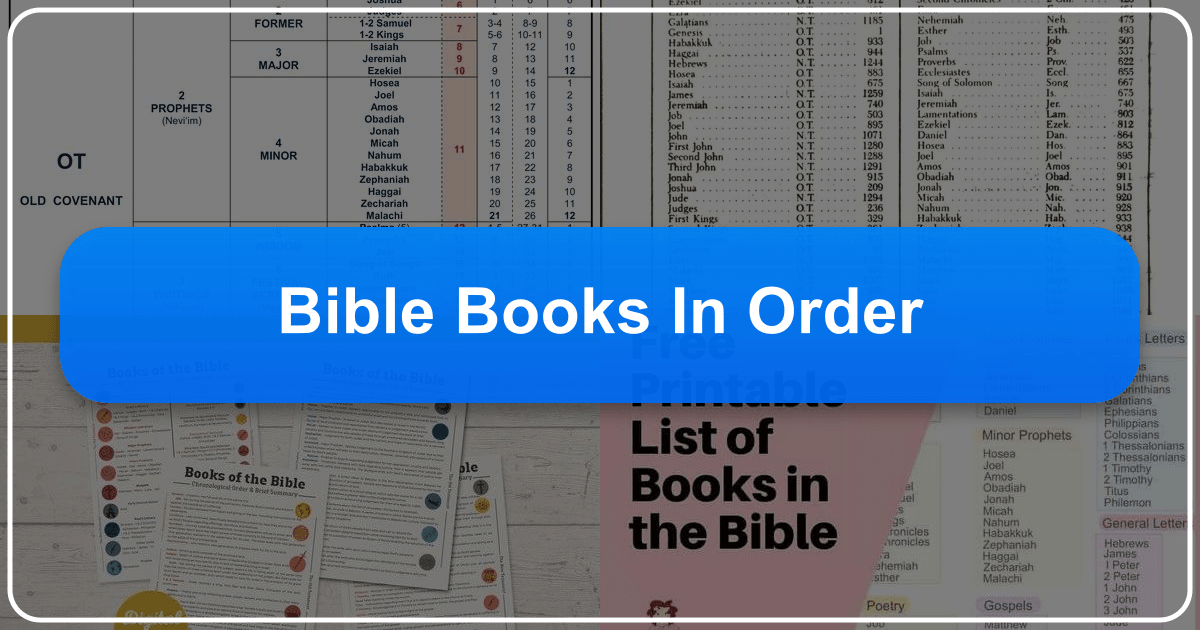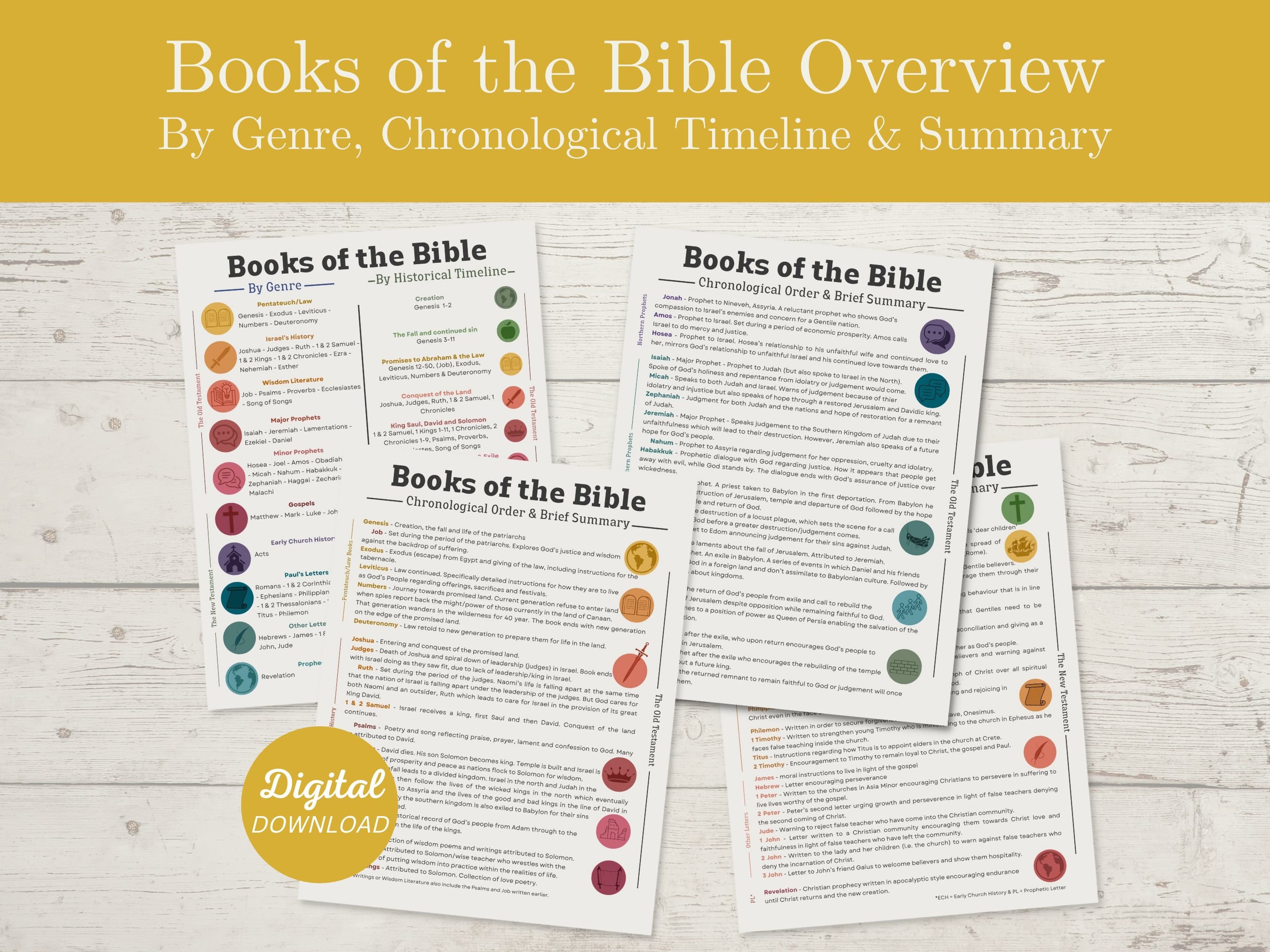The 66 Books of the Bible: A Comprehensive Guide in Order

Navigating the Bible’s 66 books can feel daunting, yet this journey reveals a rich tapestry of narratives and teachings that have profoundly shaped human history and spirituality. This comprehensive guide will explore each book, offering insights into their traditional authorship, approximate dates of composition, key themes, and concise summaries. We’ll examine the different ways the Bible is organized, considering the canonical order and chronological arrangement, and explore the significance of both approaches to understanding the overarching message of scripture.
The Old Testament: The First 39 Books
The Old Testament, also known as the Hebrew Bible, comprises 39 books, traditionally divided into several categories. However, the specific categorization and order of books have varied across different historical periods and religious traditions. We will explore the most common groupings used today:
Categorization of Old Testament Books

The Protestant, Roman Catholic, and Greek Orthodox traditions generally recognize the following divisions within the Old Testament:
-
Books of Law (5): These books, also known as the Torah (Hebrew) or Pentateuch (Greek), form the foundational legal and narrative basis for Jewish and Christian faiths. They detail the creation of the world, the covenant between God and Israel, and the establishment of Israelite law and ritual. The five books are: Genesis, Exodus, Leviticus, Numbers, and Deuteronomy.
-
Books of History (12): These books trace the history of the Israelites from their conquest of Canaan to the period of the Babylonian exile. They chronicle the lives of significant figures like Joshua, the judges, and the kings of Israel and Judah. The twelve books are: Joshua, Judges, Ruth, 1 Samuel, 2 Samuel, 1 Kings, 2 Kings, 1 Chronicles, 2 Chronicles, Ezra, Nehemiah, and Esther.
-
Books of Poetry (5): This section comprises wisdom literature and poetry, exploring themes of faith, suffering, love, and the human condition. The five books are: Job, Psalms, Proverbs, Ecclesiastes, and Song of Songs.
-
Books of Major Prophets (5): These books contain the writings of prominent prophets who delivered God’s messages to the Israelites, often addressing issues of social justice, idolatry, and the consequences of disobedience. The five books are: Isaiah, Jeremiah, Lamentations, Ezekiel, and Daniel.
-
Books of Minor Prophets (12): Like the major prophets, these books contain prophecies and messages from various prophets, but their books are shorter in length. The twelve books are: Hosea, Joel, Amos, Obadiah, Jonah, Micah, Nahum, Habakkuk, Zephaniah, Haggai, Zechariah, and Malachi.
The Hebrew Bible, however, organizes the books differently, grouping them into Torah (Law), Nevi’im (Prophets), and Ketuvim (Writings). The Prophets are further subdivided into Former Prophets (Joshua, Judges, Samuel, Kings) and Latter Prophets (Isaiah, Jeremiah, Ezekiel, the Twelve Minor Prophets). The Writings include diverse genres such as poetry, wisdom literature, and historical accounts. This difference highlights the evolving understanding and interpretation of the scriptures throughout history.
Old Testament Books in Canonical Order
The canonical order, which is the standard order found in most Bibles, presents the Old Testament books as follows:
- Genesis
- Exodus
- Leviticus
- Numbers
- Deuteronomy
- Joshua
- Judges
- Ruth
- 1 Samuel
- 2 Samuel
- 1 Kings
- 2 Kings
- 1 Chronicles
- 2 Chronicles
- Ezra
- Nehemiah
- Esther
- Job
- Psalms
- Proverbs
- Ecclesiastes
- Song of Songs
- Isaiah
- Jeremiah
- Lamentations
- Ezekiel
- Daniel
- Hosea
- Joel
- Amos
- Obadiah
- Jonah
- Micah
- Nahum
- Habakkuk
- Zephaniah
- Haggai
- Zechariah
- Malachi

The New Testament: The Last 27 Books
The New Testament focuses on the life, teachings, death, and resurrection of Jesus Christ, as well as the early development and spread of Christianity. It primarily consists of Gospels, historical narratives, letters (epistles), and an apocalyptic vision.
Categorization of New Testament Books
The New Testament books are generally categorized as follows:
-
Gospels (4): These four accounts of Jesus’ life and ministry provide different perspectives and theological emphases. The four Gospels are: Matthew, Mark, Luke, and John.
-
Acts of the Apostles (1): This book continues the narrative from the Gospels, chronicling the early expansion of the Christian church after Jesus’ ascension.
-
Pauline Epistles (13): These letters, written by or attributed to the Apostle Paul, address various churches and individuals, offering theological instruction, moral guidance, and pastoral advice. These include: Romans, 1 Corinthians, 2 Corinthians, Galatians, Ephesians, Philippians, Colossians, 1 Thessalonians, 2 Thessalonians, 1 Timothy, 2 Timothy, Titus, and Philemon.
-
General Epistles (7): These letters, written by various authors, offer guidance and encouragement to a broader Christian audience. These include: Hebrews, James, 1 Peter, 2 Peter, 1 John, 2 John, and 3 John.
-
Revelation (1): This book, also known as the Apocalypse, is a symbolic and visionary work describing the end times and the ultimate victory of God.
New Testament Books in Canonical Order
The canonical order of the New Testament books is:
- Matthew
- Mark
- Luke
- John
- Acts
- Romans
- 1 Corinthians
- 2 Corinthians
- Galatians
- Ephesians
- Philippians
- Colossians
- 1 Thessalonians
- 2 Thessalonians
- 1 Timothy
- 2 Timothy
- Titus
- Philemon
- Hebrews
- James
- 1 Peter
- 2 Peter
- 1 John
- 2 John
- 3 John
- Jude
- Revelation
Canonical Order vs. Chronological Order

It’s crucial to understand that the canonical order of the Bible’s books does not reflect their chronological order of composition. The books were compiled over centuries, and their arrangement reflects literary categories and theological priorities rather than a strict timeline. While the internal chronology within individual books is generally consistent, placing the entire Bible in chronological order requires careful consideration of historical and literary context.
A chronologically ordered Bible would significantly alter the reading experience, potentially impacting how readers perceive the unfolding of God’s plan and the development of religious thought. For example, reading the prophets chronologically would present a different narrative flow compared to their current arrangement.
The Importance of Different Reading Approaches
Both the canonical and chronological orders offer unique advantages for Bible study. The canonical order allows readers to engage with thematically related texts, fostering deeper understanding of specific theological concepts. The chronological order provides a historical narrative that can enhance appreciation for the context in which these books were written and received. Ultimately, the best approach depends on the reader’s goals and preferences. Many readers find value in using both approaches at different times.
Book Summaries (Abbreviated for Brevity)
Due to space constraints, detailed book summaries are omitted here. However, Lbibinders.org provides extensive resources that cover the content and context of each book. Readers are encouraged to utilize these resources for in-depth exploration of each individual book’s themes, narratives, and theological significance.
Conclusion
This overview serves as an introduction to the 66 books of the Bible, highlighting their organization and the diverse literary genres they encompass. Readers are encouraged to engage with the Bible using a variety of approaches, seeking to understand the historical, literary, and theological contexts that shape each book’s message. Lbibinders.org offers valuable tools and resources to support this endeavor, facilitating a richer and more meaningful engagement with the scriptures.